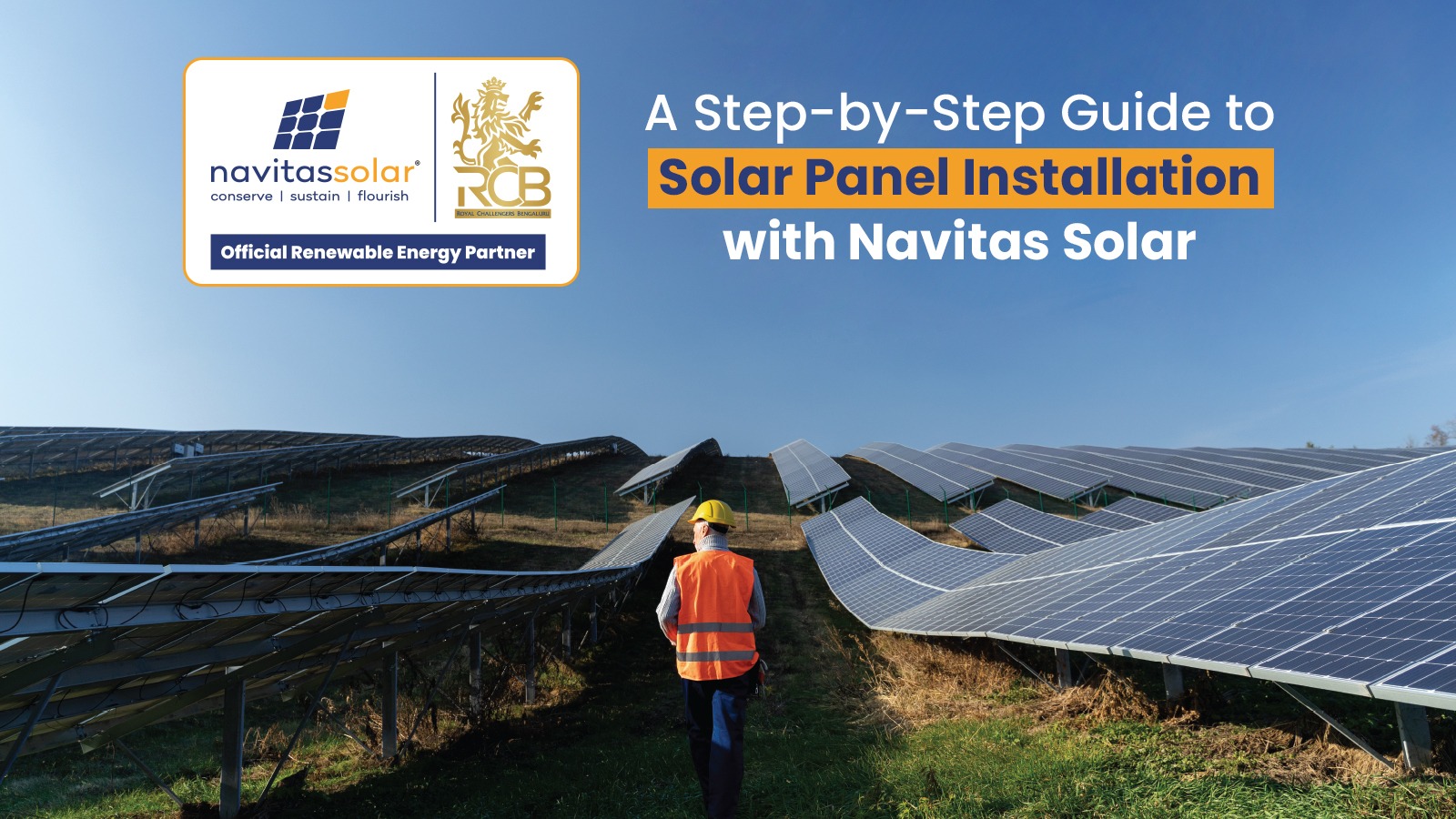A Step-by-Step Guide to Solar Panel Installation with Navitas Solar
Have you ever been curious about how solar panels are installed? In this article, we will take a deep dive into how solar panels are fitted in homes and commercial spaces. So, you know what to expect from the team installing your solar panel. While the process may seem complicated, it is, in fact, straightforward for a professional.
Navitas Solar is India’s leading solar panel manufacturer with a decade of experience. We manufacture and install your solar system to help you embrace sustainable energy. Let’s understand the process of installing your solar panel!
Solar Panel Installation Site Survey For Solar Installation
Whether buying a house or building your factory, a location survey is a must because it plays a crucial role in the strength of your establishment. Likewise, a site survey is a must when installing a solar panel. The location of the installation depends on:
- The compatibility of the site for installing solar panels.
- The number of panels that’ll fit the space.
- The voltage required for the solar panel.
- The number of supporting hooks and clamps needed.
- The route to install rails and inverter batteries.
- The earthing process for the solar panel.
A site survey allows us to understand if space can hold the solar panel system. Additionally, it helps one to estimate the materials and cost of solar panel installation.
Civil Work to Support the Solar Panel
The solar panel has electricity flowing through it. Thus, it is more susceptible to electric leakage and other mishaps. The plan must pass the civil structure assessment to avoid such situations. It inspects the land surrounding the solar plant, the structural design of the solar plant, and more. Once the plan is approved, you can install solar panels.
Solar Panel Stand Installation in the Area
Initially, set up the basic stand for installing solar panels. This stand includes installing railings with the help of hooks and clamps. This stand’s size depends on the size of the panels and their numbers. Our bodies need to absorb vitamin D from sun rays. Likewise, solar panels also need to absorb sun rays to generate electricity. Thus, the panels need to be at an angle of 15-20 degrees. The stand structure may vary depending on the type of roof or surface.
- For Flat Surface: If you have a flat surface, you need a stand that provides height. You will need extra rods and clamps to create a 15-20-degree angle for the solar panel.
- For Slope Surface: If you have a slope, you are good to start the installation. First, install the roof hooks depending on the design of the railing installation. Now, one can choose whether they want to install the clamps first or directly install the railing. You can install the end and mid clamps to the railing. In contrast, you can install the end clamps on the roof and position the railings. Connect each railing with rail connectors to secure the panel stand.
Solar Panel Installation Connection on the Stand
Once you ensure that the panel stand is sturdy without any loose nuts, it’s time to assemble the solar panels! To begin with, you need to get the most suitable panels for you. Navitas Solar has been one of the best solar panel companies to get your panels. We have various panels ranging from multi-crystalline, mono-crystalline, and MONO PERC half-cut and next generation N type TOPCon modules.
Now, secure the edge of the solar panel on the edge of the railing per the finalized design. If installing many layers on your home terrace, start with the topmost layer.
Panel Wiring to Get Electricity Flowing
After installing the panels, you need to connect them to get the electricity flow. Firstly, connect the panels in series connection for constant capacity (amp) or parallel connection for constant voltage. Following this, connect the DC and AC wires to the ends panel and connect them to the converter using an MC4 connector. At this point, you must connect the solar charge controller to control Undervoltage and Overvoltage.
Inverter Connection for AC Electricity
The electricity from sun rays is DC (direct current), which you can’t use. First, you need to convert it to AC (alternating current). Hence it is necessary to have an inverter to convert the DC from the solar panel to AC and divert it into the primary electric system of your house or office. You must connect the negative and positive solar panel wires with the allocated slots in the inverter because electricity will flow through them.
Battery Connection to Store Electricity
Depending on the on-grid or off-grid systems, you must connect the batteries. For an on-grid system, the excessive electricity produced can either be routed to your desired electricity company or can be stored. For an off-grid panel system, you need a battery. Join opposite charging ends of the wire to the battery and inverter. This way, the excessive electricity generated will be stored in the battery for later use.
Earthing Kit Installation for Solar System
Electricity is constantly flowing through the solar panel system. Thus, it increases the chance of current leakage. Additionally, the open placement of solar panels puts them at risk of thunderstorms. To avoid mishaps, install a lightning arrestor (a rod-like structure) at the highest point of your panel stands. The rod will attract the electric strike surrounding the panel to ensure its safety. Then, ground the bottom of the panels with the earth. Especially if you have installed the solar panel on the ground, it helps tackle electricity leakage by transferring electricity to the neutral ground.
Conclusion
Installing a solar panel requires attention to minute details. We discussed a detailed guide to help you with solar panel installation. First, you need to check the compatibility of the available space to install the solar panel. Determine the number of panels you will need and their wattage. The civil team decides whether the ground can sustain a solar plan and passes the plan’s design. Following this, you must determine the panel stand style based on the flat or sloped surface. Secure the railings in the desired design using roof hooks and clamps. Install the panels on the railing and wire them in a series or parallel connection. Now, connect the wires to the inverter and batteries using connectors. A commercial solar company like Navitas Solar can simplify this process. Take the first step with solar panel installation and embrace sustainable energy!
FAQs
Can I Do Solar Panel Installation Myself?
A simple answer is yes. But you need some experience with electric systems and resources. You might need specialized hardware along with many permits. Hiring a solar panel installation team can save you time and energy. Navitas Solar, a commercial solar company, is a trustable solar panel manufacturer in India providing EPC service. From creating your solar panels to installing them, we provide a hassle-free experience.
How Much Does Solar Installation Cost?
The solar installation cost varies on various factors. A few of them are the types of panels, voltage requirements, panel stands setup, battery and inverters, labor charges, logistics, and more. We are happy to help you calculate a quote for your desired plan. Get In Touch with us; we are eager to hear from you!
How To Choose the Best Solar Panel Companies?
Selections can be tricky when there are many solar panel companies to choose from. However, if you are investing, you should trust someone with experience and recognized expertise. Navitas Solar is the best solar panel company in Surat, serving globally. We have been working for a decade in the solar industry with our carbon neutral solutions. We have built solar plants in Delhi, Madhya Pradesh, Maharashtra, Pune, Rajasthan, Himachal Pradesh, Daman, and more. Additionally, our firm has been recognized by many awards like Pride Of Gujarat, Solar Innovation Product of the Year etc.
Here are some additional technical points to consider when installing solar panels:
- Solar Panel Efficiency: The efficiency of a solar panel refers to its ability to convert sunlight into usable electricity. Higher efficiency means more power generation.
- Orientation and Tilt: The orientation and tilt of your solar panels can significantly affect their performance. In the Northern Hemisphere, panels should typically face south for optimal sunlight exposure.
- Shading: Solar panels should be installed in an area clear of shading between 9 am and 3 pm for maximum efficiency.
- Temperature and Ventilation: Solar panels perform best at cooler temperatures. Proper ventilation can help reduce the temperature of your panels.
- Maintenance: While solar panels generally require little maintenance, it is still important to keep them clean and check regularly for any potential issues such as loose wiring or degradation.
- Local Permits and Regulations: Before installing solar panels, you should check with local authorities about any necessary permits or regulations.
- Grid Connection: If you’re connecting your system to the grid, there will be specific requirements and procedures to follow. It’s important to understand these ahead of time.
- Warranty: Ensure your solar panels come with a warranty. Most manufacturers provide a 25-year power output warranty, which guarantees a certain level of performance for the lifetime of the panels.
- Installer Certification: The certification of the installer is crucial for both the efficiency of the installation and eligibility for governmental incentives. Certified installers are trained to adhere to safety and quality standards.
- System Monitoring: Many inverters come with system monitoring software, which allows you to track the performance of your solar panels on your computer or mobile device.


 Online | Privacy policy
Online | Privacy policy
Related Posts
You May Also Like
Bonito Series: Driving Innovation in…
Read MoreTOPCon Series: The Next Generation…
Read MoreValuable Points to Remember During…
Read MoreNavitas Planet Partners with Hysolwin…
Read MoreDriving Towards a Sustainable Future:…
Read MoreWhy Do Top-Grade EVA Sheets…
Read MoreBonito Series: Driving Innovation in…
Read MoreTOPCon Series: The Next Generation…
Read MoreValuable Points to Remember During…
Read MoreNavitas Planet Partners with Hysolwin…
Read MoreDriving Towards a Sustainable Future:…
Read MoreWhy Do Top-Grade EVA Sheets…
Read MoreBonito Series: Driving Innovation in…
Read MoreTOPCon Series: The Next Generation…
Read MoreValuable Points to Remember During…
Read MoreNavitas Planet Partners with Hysolwin…
Read More